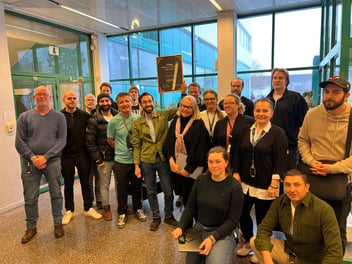by Joacim Harrby
A path to sustainable flow orientation through involvement and training in small steps
"When we only trained a few people in management, we saw no significant change in the organization. It felt like we were trying to row a boat forward, but without oars. We had good ambitions and a clear direction, but nothing happened." — Management team member
Let’s Send Someone to a Course
It is a common problem in many organizations that only a small portion of the employees receive training and inspiration to drive change. Many talk about "sending someone to a course" or the constant pursuit of recruiting someone who is "certified." When an individual employee attends a course and is then appointed as the responsible team member for driving change projects, it often leads to slow, fragmented, and inefficient initiatives. The organization quickly falls back into old ways of working and loses momentum leaving many in the company asking themselves "when will this blow over?"
It is not uncommon for most failed implementations of new work methods (new business strategies) to be traced back to an inability to involve the entire organization in the change effort. Training all employees in what we aim to achieve and how we can achieve it is a key to success.
Even though we try to involve more employees in traditional training, where participants gather for a few intense days, this often overloads the individuals with information and makes it difficult to spread the knowledge throughout the company. When no continuity exists and, this is often the case, only external theoretical cases are discussed, the lessons quickly become irrelevant to the employees in their daily operations.
The Whole Organization as a Driving Force for Change
This is where I have seen a clear difference lately. By involving all employees in an organization, we create opportunities that would otherwise be lost. Flow orientation, which Hups focuses on, requires a holistic approach. It is about solving customer needs through collaboration between different departments, and it cannot be implemented effectively unless all parts of the organization have a fundamental understanding of the whole.
Over the past three years, we have seen powerful results from our clients who have chosen to involve all their staff in the development process. By training all employees in small steps over time, the change has become both faster and more sustainable. Continuous training sessions and weekly meetings focused on developing internal work methods are one example from our clients where everyone gets the opportunity to apply what they’ve learned early on.
Our clients are clear on their demands: they need to run their operations while also developing their employees.
At first, it may seem demanding to both develop and fulfill daily responsibilities, but participants over the past few years have found it both easy and inspiring. They have gained a deeper understanding of what is actually required to create flow-oriented and self-improving organizations, thanks to the small-step training that is made specific to their context. A specific pedagogical method can make the knowledge easy to apply in everyday life.

What Happens When Everyone Is Involved Digitally as Well as Physically?
Our mission is to combine a digital platform with physical meetings to create a flexible and inclusive learning environment, where employees can participate in the change process regardless of where they are. When the entire organization is involved in learning from a standardized context with a focus on their own business and challenges, the following outcomes are achieved:
Improved understanding of the entire flow: When every employee, regardless of position or department, understands how their work affects the whole, not only efficiency increases but also the quality of deliveries.
Faster changes: When more people are involved and take responsibility for improvement work, changes happen faster. It’s no longer just a few people driving projects, but the entire organization working toward common goals.
Sustainability in improvement efforts: By allowing managers and employees to continuously develop and receive training, changes don’t stall. Knowledge is spread effectively and long-term within the organization, leading to sustainable improvements.
Increased engagement: When employees feel involved and see how their work contributes to the company’s success, motivation and engagement increase significantly.
Examples From Our Clients
Over the past three years, we have seen several examples of how this method has created faster and more sustainable changes.
One of our clients managed to train 99.7% of their 1000+ employees in just a few months, laying the foundation for a concept that they developed for the entire company. This contributed to them becoming a market leader today.
Another client saw significant progress when we reduced their maintenance times from 31 to 6 days by involving a cross-functional team from three different offices. These results wouldn’t have been possible without broad and deep involvement from the entire organization.
A CEO we have worked with since the start of Hups frequently mentions that "a seed has been planted in the organization that has taken root. We cannot work in any way other than flow-oriented, and the engine is all employees improvement work."
Involving Everyone in Developing a Flow-Oriented Business Strategy Is the Key to Success
Flow orientation is a strategy that requires a deep understanding and commitment from the entire organization. Limiting training to a few employees leads to sub-optimization and lost opportunities. By involving all managers and employees systematically and over time, we build an organization that not only is capable of changing quickly but also creates sustainable improvements over time.
Like many others, we have understood the value of the *train-the-trainer* concept and, in our continuous improvement work of our own methods, have developed two complementary methods: Train-the-Leader and Train-the-Expert.
Train-the-Leader (TTL): We aim to develop our clients’ managers so that they can lead their own improvement programs. Managers are not only trained in flow orientation and change management, but they are also equipped with the tools to engage and inspire their teams over time via specific facilitation techniques. Through regular training and coaching, we help create leaders who are capable of driving continuous improvements with the help of all their employees.
Train-the-Expert (TTE): As well as training leaders, our goal is to train and develop our clients' internal experts so they can deepen their expertise and lead different versions of improvement initiatives. This method allows experts not only to solve current problems but also to create conditions for long-term innovation and efficiency within the organization by training other leaders and, in the long run, their own experts.
By using TTL and TTE as complements to our standardized or customized training programs, we aim to create an internal development channel that makes it possible to quickly and efficiently drive change. At the same time, our mission is to develop internal resources that can continue the work long after the initiative has started. This ensures sustainable improvements and makes the organization self-improving over time.




